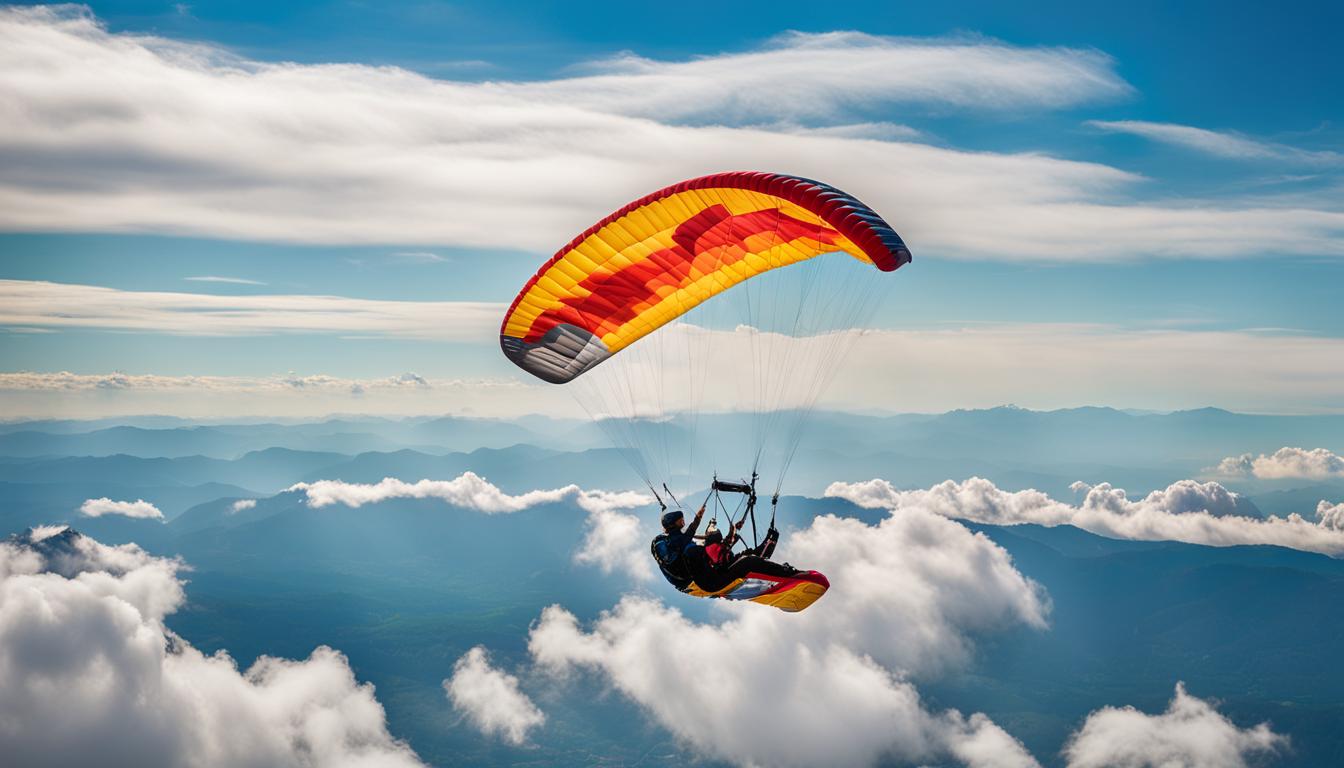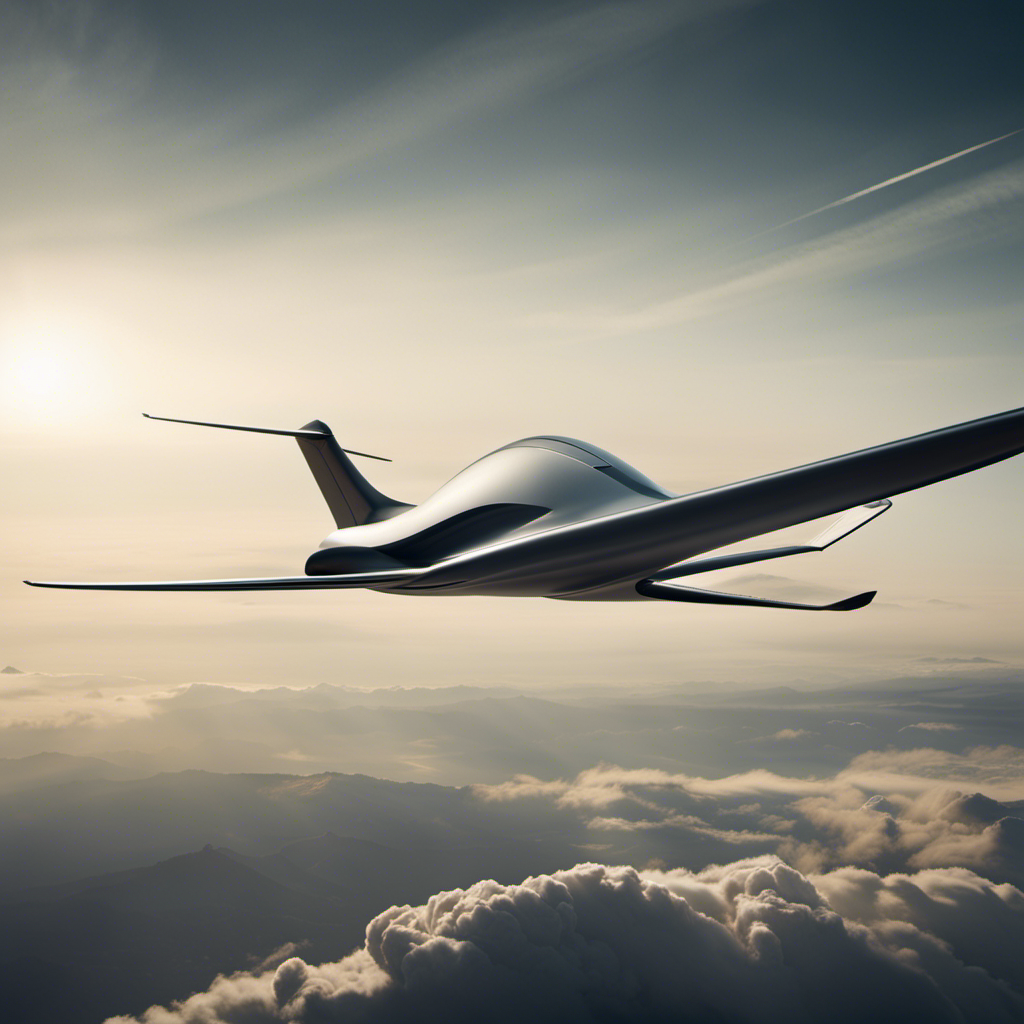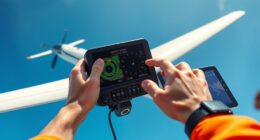Paragliding and hang gliding are both thrilling aerial sports that give people the opportunity to glide through the sky. Even though they have similarities, there are distinct differences between the two. Join us as we delve into the excitement, beauty, and passion of paragliding and hang gliding in this thrilling battle of the skies.
Key Takeaways:
- Paragliding and hang gliding are both thrilling aerial sports that offer unique experiences in the sky.
- Paragliding involves flying under a flexible wing, while hang gliding uses a rigid wing.
- Paragliding is considered safer due to slower speeds and softer landings.
- Hang gliding requires more skill and physical exertion, offering higher speeds and aerobatic maneuvers.
- Choosing between paragliding and hang gliding depends on personal preferences, skill level, and commitment.
The Basics of Paragliding
Paragliding is an exhilarating aerial sport that allows individuals to experience the thrill of flying. It involves flying under a wing-like canopy, which is made of nylon fabric and supported by suspension lines. This foot-launched sport requires minimal equipment, making it accessible for enthusiasts of all levels. The primary equipment used in paragliding includes a paragliding wing, harness, helmet, and reserve parachute.
Safety is paramount in paragliding, as pilots rely on thermals and updrafts to stay aloft. It is crucial for individuals to undergo proper training and acquire the necessary knowledge to navigate the skies safely. Additionally, pilots must ensure that their equipment is well-maintained and regularly inspected to minimize any potential risks.
The equipment used in paragliding is designed to offer stability, maneuverability, and ease of use. The paragliding wing is flexible, allowing for easy transport and setup. The harness provides comfort and safety, while the helmet protects the pilot’s head during flight. The reserve parachute serves as a crucial backup in case of emergencies, providing an additional layer of safety.
Comparing Safety Measures
When comparing the safety aspects of paragliding and hang gliding, it is important to consider the differences in equipment and flying techniques. Paragliding is often considered safer due to its slower speeds and softer landings. The flexible wing and suspension lines provide a level of stability and control, making it easier for pilots to handle various flying conditions.
| Paragliding | Hang Gliding | |
|---|---|---|
| Safety | Slower speeds and softer landings make it relatively safer. | Requires more skill and experience to handle high speeds and hard landings. |
| Equipment | Flexible wing and suspension lines provide stability and control. | Rigid wing requires more physical exertion and technical knowledge to maneuver. |
Hang gliding, on the other hand, requires more skill and experience to mitigate risks associated with high speeds and hard landings. Pilots must possess a higher level of physical exertion and technical knowledge to handle the rigid wing and perform maneuvers safely.
Ultimately, both paragliding and hang gliding offer their own unique thrills and challenges. It is essential for individuals to assess their abilities, undergo proper training, and prioritize safety to ensure a safe and enjoyable flying experience.
The Thrills of Hang Gliding
Hang gliding is an adrenaline-fueled sport that offers a unique soaring experience. With its rigid wing and higher glide ratio, hang gliding allows for faster speeds and the potential for performing aerobatic maneuvers. This sport attracts thrill-seekers who crave the rush of excitement and the opportunity to push their limits in the sky.
However, hang gliding does require a greater level of physical exertion and technical knowledge compared to paragliding. Beginners may find the learning curve steeper, as mastering the skills and techniques necessary for safe hang gliding flight takes time and dedication. Proper training and mentoring are essential for beginners to develop the necessary skills and gain confidence in their abilities.
Despite the challenges, hang gliding enthusiasts find immense joy in the freedom and exhilaration that comes with this sport. Soaring above the ground and witnessing the world from a bird’s-eye view provide a profound sense of freedom and connection with nature. The ability to navigate through the air, harnessing the power of wind and thermals, is a thrilling experience that few other sports can match.

Quotes:
“Hang gliding gives you the ultimate feeling of flight. It’s like being one with the sky and experiencing true freedom.” – John, experienced hang glider
“The rush of adrenaline you get from hang gliding is addictive. Once you experience the thrill, you’ll want to keep coming back for more.” – Sarah, hang gliding enthusiast
Table: Pros and Cons of Hang Gliding
| Pros | Cons |
|---|---|
| High-speed flights | Requires more physical exertion |
| Aerobatic maneuvers | Steeper learning curve |
| Greater sense of freedom | Requires specialized training |
| Breathtaking views from above | Higher risk of injury for beginners |
| Ability to navigate wind and thermals | Higher upfront costs for equipment |
Comparing Safety and Risk Factors
When it comes to paragliding vs hang gliding, safety is a crucial consideration. Both sports involve flying in natural elements and are subject to changes in weather conditions, which can pose inherent risks. However, there are notable differences in the safety and risk factors associated with each sport.
Paragliding Safety
Paragliding is often considered safer compared to hang gliding due to several factors. One key advantage is the slower speeds at which paragliders fly. The lower speed allows for greater maneuverability and easier control, reducing the risk of accidents or collisions. Additionally, paragliders have a softer landing due to the flexible canopy and suspension lines, which absorb impact better than the rigid wing of a hang glider.
- Slower speeds provide greater control and maneuverability.
- Softer landings due to the flexible canopy and suspension lines.
Hang Gliding Safety
Hang gliding requires a higher level of skill and experience to mitigate the risks associated with its characteristics. Hang gliders have a higher glide ratio, allowing them to achieve faster speeds and cover longer distances. While this provides an exhilarating experience, it also poses greater challenges in terms of control and landing. Hard landings can be a concern in hang gliding, especially for beginners who are still learning the techniques and mastering the sport.
- Higher speeds and longer distances covered.
- Potential for harder landings, especially for beginners.
Ultimately, the choice between paragliding and hang gliding should be made based on an individual’s comfort level, skill, and risk tolerance. Both sports offer the thrill of flight and the opportunity to explore the skies, but it is important to prioritize safety and undergo proper training and equipment inspections regardless of the chosen sport.
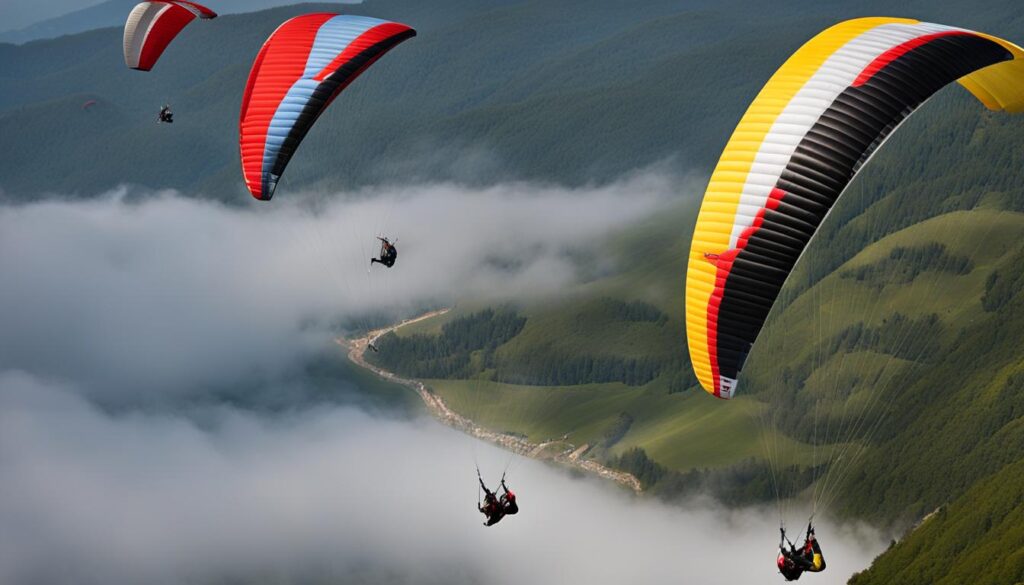
Table: Safety and Risk Factors Comparison
| Paragliding | Hang Gliding | |
|---|---|---|
| Speed | Slower speeds, providing greater control and maneuverability. | Higher speeds and longer distances covered, requiring advanced control skills. |
| Landing | Softer landings due to flexible canopy and suspension lines. | Potential for harder landings, especially for beginners. |
| Skill Requirement | Less skill-intensive, suitable for beginners. | Higher skill requirement, requires more experience and training. |
| Risk Tolerance | Lower risk potential, ideal for those who prioritize safety. | Higher risk potential, suitable for thrill-seekers with higher risk tolerance. |
It is important to carefully assess your own abilities, seek proper training, and consult with experienced pilots when choosing between paragliding and hang gliding. By prioritizing safety and being aware of the risk factors, you can ensure a safe and enjoyable flying experience.
Exploring the Equipment
When it comes to paragliding and hang gliding, the equipment used plays a crucial role in the overall experience. Each sport has its own unique set of gear, designed to maximize performance and safety. Let’s take a closer look at the equipment required for paragliding and hang gliding.
Paragliding Equipment
In paragliding, the primary piece of equipment is the paragliding wing. This wing, also known as a canopy, is made of lightweight and durable nylon fabric. It is designed to provide both lift and stability, allowing pilots to stay airborne. The wing is supported by a system of suspension lines, which are attached to a harness worn by the pilot. The harness provides a comfortable and secure seating position, allowing for easy control of the wing. Additionally, pilots wear a helmet for safety and a reserve parachute as a precautionary measure in case of emergencies.
Hang Gliding Equipment
Hang gliding, on the other hand, utilizes a different type of wing called a hang glider. Hang gliders have a rigid frame made of aluminum, with a fabric wing stretched tightly over it. This design allows for greater control and stability at higher speeds. Pilots are suspended from the hang glider using a harness system that connects to the frame. Similar to paragliding, hang gliding pilots wear helmets for safety and may also use a reserve parachute for added security.
| Component | Paragliding | Hang Gliding |
|---|---|---|
| Wing | Flexible nylon fabric | Rigid aluminum frame with fabric wing |
| Suspension System | Lines attached to a harness | Harness system connected to the frame |
| Helmet | Worn for safety | Worn for safety |
| Reserve Parachute | Used as a precautionary measure | Used as a precautionary measure |
Both paragliding and hang gliding equipment have undergone significant advancements over the years, with a focus on improving performance and safety. It is important for pilots to regularly inspect and maintain their equipment to ensure optimal functionality. Additionally, choosing the right equipment that suits individual preferences and flying conditions is key to a successful and enjoyable experience in either sport.
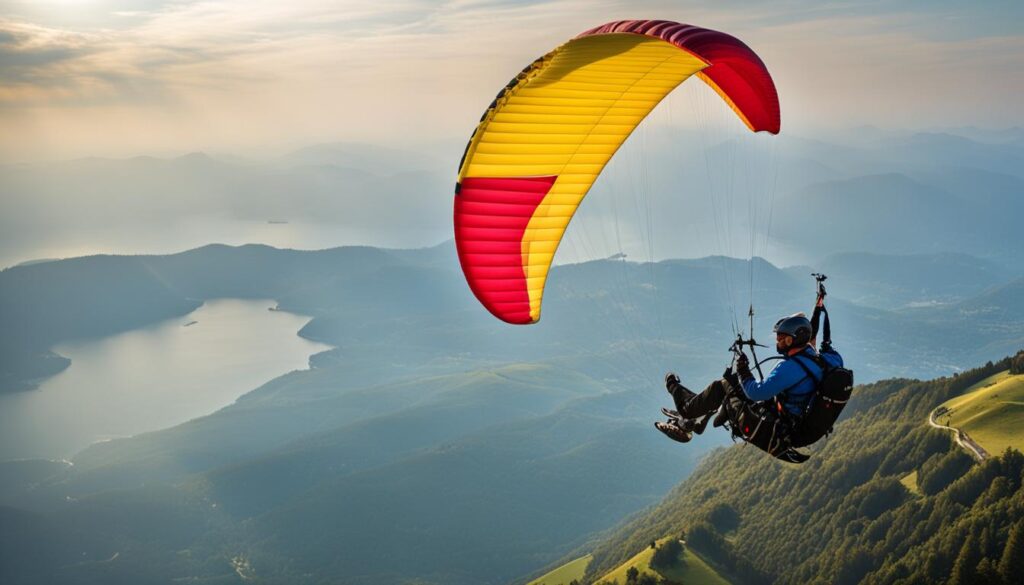
So whether you’re soaring through the skies under a paragliding wing or gliding gracefully on a hang glider, the equipment you choose will be your trusted companion on your aerial adventures. Each piece of gear has been carefully designed and engineered to provide you with an unforgettable experience. Embrace the thrill, harness the power of the wind, and embark on your journey into the limitless sky!
The Cost Analysis
When considering whether to take up paragliding or hang gliding, it’s important to take into account the cost associated with each sport. While both offer thrilling experiences, there are differences in terms of upfront expenses and ongoing costs.
Paragliding generally has a lower barrier to entry in terms of cost. The equipment required for paragliding, such as a paragliding wing, harness, helmet, and reserve parachute, tends to be more accessible and affordable compared to hang gliding. Additionally, paragliding training fees are often more affordable as well. These factors make paragliding a more budget-friendly choice for those who want to experience the joy of soaring through the sky.
Hang gliding, on the other hand, may involve higher upfront costs. The rigid wing used in hang gliding requires more specialized equipment, such as an aluminum and fabric wing, as well as additional gear like a harness and helmet. These items may be more expensive compared to the equipment used in paragliding. Hang gliding training fees can also be higher due to the level of skill and knowledge required to safely pilot a hang glider. However, for those who are truly passionate about the sport, the investment can be well worth it.
| Paragliding | Hang Gliding | |
|---|---|---|
| Equipment Costs | Lower | Higher |
| Training Fees | Affordable | Potentially higher |
| Ongoing Costs | Minimal | Moderate |
It’s important to note that ongoing costs, such as insurance, maintenance, and travel expenses, can vary for both sports. Paragliding often has minimal ongoing costs, as the equipment is easier to maintain and less prone to wear and tear. Hang gliding may require more frequent inspections and maintenance due to the rigid wing design. Additionally, travel expenses should be taken into account, as certain locations may offer better flying conditions and opportunities for both sports.
Ultimately, the cost analysis should be just one factor to consider when deciding between paragliding and hang gliding. Each sport offers its own unique thrills and challenges, and the decision should also take into account personal preferences, skill level, and long-term commitment. What matters most is finding a sport that brings joy and fulfillment in the sky.
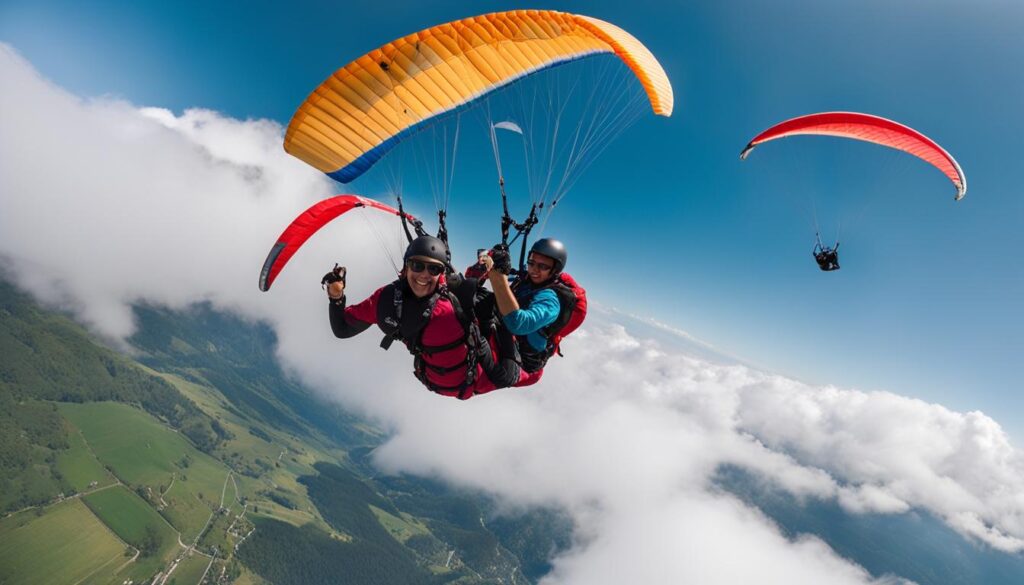
Adrenaline Junkies Delight
For adrenaline junkies, both paragliding and hang gliding offer the ultimate thrill in the sky. The rush of adrenaline that comes from soaring through the air and defying gravity is unmatched. Whether it’s the sensation of riding thermals and going cross-country in paragliding or the ability to perform aerobatic maneuvers and achieve high speeds in hang gliding, both sports provide an exhilarating experience that will leave you craving more.
Paragliding, with its smooth gliding and graceful maneuvers, allows you to feel like you’re flying with the birds. The feeling of freedom and weightlessness as you soar above stunning landscapes is a truly awe-inspiring experience. The slow and steady pace of paragliding gives you ample time to take in the breathtaking views and savor every moment of your flight.
Hang gliding, on the other hand, offers a more adrenaline-fueled adventure. The high-speed flights and the ability to perform thrilling aerobatic maneuvers will push your limits and give you an unparalleled rush. The feeling of the wind rushing past you as you navigate through the air is an adrenaline junkie’s dream come true.
Quote
“Paragliding and hang gliding are not just sports, they are a way of life for adrenaline junkies like us. The feeling of freedom and the rush of adrenaline make every flight an unforgettable experience.” – Experienced Paraglider and Hang Glider
Whether you choose paragliding or hang gliding, both sports offer an incredible adrenaline-pumping experience that will leave you with memories to last a lifetime. It’s all about finding the right balance between the thrill of the adventure and the safety measures that ensure a memorable experience. So, if you’re an adrenaline junkie looking for an unforgettable skyward adventure, both paragliding and hang gliding are sure to satisfy your craving for excitement.
| Paragliding | Hang Gliding | |
|---|---|---|
| Speed | Slower speeds, allowing for a more relaxed flight. | Higher speeds, offering an exhilarating and fast-paced experience. |
| Maneuverability | Smooth and graceful maneuvers, with the ability to catch and ride thermals for longer flights. | Aerobatic maneuvers and the ability to perform tricks and stunts in the air. |
| Learning Curve | Shorter learning curve, making it more accessible to beginners. | Requires a greater level of commitment and skill development. |
| Equipment | Minimal equipment required, making it easier to transport and set up. | Rigid wing requires disassembly for transport and set up. |
| Risks | Considered safer due to slower speeds and softer landings. | Requires more skill and experience to mitigate risks associated with higher speeds and harder landings. |
The Beauty of Flight
When it comes to paragliding and hang gliding, one of the most awe-inspiring aspects is the sheer beauty of flight. Both sports offer a unique perspective on the world and allow us to witness breathtaking views from above. Whether soaring above majestic mountains, gliding along picturesque coastlines, or floating above rolling countryside, the experience is truly magical.

The sensation of flying like a bird, being immersed in the vastness of the sky, creates a sense of freedom and wonder. As we glide effortlessly through the air, we find ourselves captivated by the beauty that surrounds us. The changing colors of the landscape, the play of light and shadows, and the ever-changing patterns of nature unfold beneath us, creating a visual feast for the senses.
Paragliding and hang gliding allow us to connect with nature in a profound way. We become part of the elements, harnessing the power of wind and thermals to stay aloft. It’s a dance with the forces of nature, where we navigate through invisible currents and ride the invisible waves. This intimate interaction with the environment not only deepens our appreciation for the natural world, but also fosters a sense of peace and serenity.
Experiencing the Elements
As we soar through the sky, we can feel the wind on our faces and the sun on our skin. The elements become our companions, guiding us on our journey. The sensation of flying through the cool, crisp air is invigorating, revitalizing both our bodies and our spirits. It’s a sensory experience unlike any other, where the rhythm of our heartbeat aligns with the rhythm of the flight.
Paragliding and hang gliding offer a unique perspective on the world, allowing individuals to witness breathtaking views and experience a sense of freedom.
Both paragliding and hang gliding allow us to escape the confines of the ground and embrace the boundless possibilities of the sky. The beauty of flight lies not only in the physical act of soaring through the air, but also in the profound connection it creates between us and the world around us. It’s a reminder of the incredible wonders that exist beyond our everyday lives and an invitation to explore and appreciate the beauty that surrounds us.
| Paragliding | Hang Gliding | |
|---|---|---|
| Equipment | Flexible wing that allows for easy transport and setup | Rigid wing that requires disassembly for transport and setup |
| Flight Experience | Soaring through the air like a bird | Performing aerobatic maneuvers and high-speed flights |
| Accessibility | Easier entry point with a shorter learning curve | Requires a greater level of commitment and skill development |
| Speed | Slower speeds, allowing for a more relaxed flight | Faster speeds and higher glide ratio |
| View | 360-degree panoramic views of the surrounding landscape | Wide-angle view with a greater sense of speed |
Choosing the Right Sport for You
When it comes to choosing between paragliding and hang gliding, it’s important to consider your personal preferences, physical capabilities, and goals. Both sports offer unique experiences and challenges, so let’s explore the key differences and factors to help you make an informed decision.
Physical Demands and Learning Curve
Paragliding is often considered more beginner-friendly, with a shorter learning curve and less physical demands. It involves flying under a flexible canopy and relies on thermals and updrafts for lift. Hang gliding, on the other hand, requires a greater level of commitment and skill development. It involves flying under a rigid wing and requires physical exertion for takeoffs and landings. If you’re looking for a sport that’s relatively easier to pick up, paragliding may be a better fit. However, if you enjoy the challenge of mastering technical skills and are willing to invest time and effort, hang gliding may be more suitable.
Speed and Control
One of the key differences between paragliding and hang gliding lies in their speed and maneuverability. Hang gliding offers higher speeds and better glide ratios, allowing for more dynamic flights and the possibility of performing aerobatic maneuvers. Paragliding, on the other hand, offers a slower and more relaxed flying experience. If you’re seeking high-speed thrills and the ability to push the boundaries of flight, hang gliding may be more appealing. If you prefer a slower pace and a focus on enjoying the scenic views, paragliding might be a better choice.
Equipment and Portability
When it comes to equipment, there are differences between paragliding and hang gliding. Paragliders use a flexible wing that can be easily packed and transported, making it more convenient for travel. Hang gliders have a rigid wing that requires disassembly for transport and setup. If portability is a priority for you, paragliding offers more flexibility. However, if you have access to a dedicated flying site and don’t mind the assembly process, hang gliding could still be a viable option.
Ultimately, the choice between paragliding and hang gliding depends on your preferences, skill level, and commitment. It’s recommended to try both sports through introductory courses or tandem flights to get a firsthand experience and see which one resonates with you. Whichever sport you choose, make sure to prioritize safety, undergo proper training, and fly within your skill level and comfort zone. Enjoy the thrill of soaring through the skies and discovering the beauty of flight!
| Paragliding | Hang Gliding | |
|---|---|---|
| Learning Curve | Easier to pick up with a shorter learning curve | Requires more commitment and skill development |
| Speed and Maneuverability | Slower pace and relaxed flights | Higher speeds and better control for aerobatic maneuvers |
| Equipment | Flexible wing for easy transport and setup | Rigid wing that requires disassembly for transport |
Safety First
Ensuring safety is paramount in both paragliding and hang gliding. These aerial sports come with inherent risks due to the nature of flying in natural elements. However, with proper training, adherence to safety guidelines, and flying within your skill level, you can enjoy a safe and exhilarating experience.
Both paragliding and hang gliding require pilots to undergo thorough training to understand the fundamentals of flight, weather patterns, and emergency procedures. This training equips pilots with the knowledge and skills necessary to make informed decisions and navigate potential risks. It is essential to complete a recognized training course and earn the necessary certifications before taking to the skies.
Flying within your skill level and comfort zone is crucial for safety. Pushing the limits without adequate experience can lead to accidents and injuries. It is important to always assess the current weather conditions and avoid flying in unfavorable or unsafe weather. Regular equipment inspections and maintenance are also vital to ensure the integrity of your gear.
“Safety is not just a priority; it is a mindset. By prioritizing safety and making well-informed decisions, we can enjoy the thrill of paragliding or hang gliding while minimizing risks.”
Connecting with experienced pilots and joining flying communities can provide valuable insights and resources for maintaining a safe and enjoyable flying experience. These communities often organize safety workshops, share best practices, and foster a culture of safety in the sport. By engaging with other pilots, we can learn from their experiences, gain valuable tips, and stay up to date with the latest safety standards.
| Paragliding | Hang Gliding | |
|---|---|---|
| Safety Considerations | Slower speeds and softer landings contribute to a perception of increased safety. | Higher speeds and harder landings require greater skill and experience to mitigate risks. |
| Training | Minimal physical demands and a shorter learning curve make paragliding more accessible for beginners. | Requires a greater level of commitment and skill development; beginners may need more training to fly safely. |
| Weather Conditions | Relatively more forgiving in adverse weather conditions due to the ability to soar on thermals and updrafts. | Requires more caution and skill to handle high-speed flights and turbulent conditions. |
Conclusion
Paragliding and hang gliding offer thrilling experiences in the sky, each with its own unique characteristics and challenges. When comparing paragliding and hang gliding, it’s important to consider personal preferences, skill level, and the level of commitment one is willing to invest.
Paragliding offers a more accessible entry point for beginners, with a shorter learning curve and less physical demands. It provides the freedom to soar through the air, ride thermals, and enjoy cross-country flights. Hang gliding, on the other hand, requires a greater level of commitment and skill development. It offers the thrill of high-speed flight, the ability to perform aerobatic maneuvers, and a higher glide ratio than paragliding.
Whether you prefer the freedom of paragliding or the adrenaline rush of hang gliding, both sports provide an incredible opportunity to explore the beauty of flight and witness breathtaking views from above. Ultimately, the choice between paragliding and hang gliding comes down to personal preference and the level of commitment one is willing to invest. Whichever sport you choose, both offer an unforgettable adventure in the skies.
FAQ
What is the difference between paragliding and hang gliding?
Paragliding involves flying under a wing-like canopy, while hang gliding involves flying under a rigid wing.
Which sport is safer, paragliding or hang gliding?
Paragliding is often considered safer due to its slower speeds and softer landings.
What equipment do I need for paragliding and hang gliding?
Paragliders require a paragliding wing, harness, helmet, and reserve parachute. Hang gliders require a hang glider, harness, helmet, and other specific equipment.
How much does paragliding and hang gliding cost?
The cost can vary depending on location, training fees, equipment costs, and insurance. Paragliding tends to be more accessible in terms of cost compared to hang gliding.
Which sport is more physically demanding, paragliding or hang gliding?
Hang gliding requires a greater level of physical exertion compared to paragliding.
Can anyone participate in paragliding or hang gliding?
Both sports require training and proper equipment. However, with the right instruction and preparation, most individuals can participate in paragliding or hang gliding.
Are there any age restrictions for paragliding and hang gliding?
Age restrictions may vary depending on location and training organizations. It is best to check with the specific regulations in your area.
Can I try both paragliding and hang gliding before deciding which sport I prefer?
Yes, introductory courses or tandem flights are a great way to experience both sports and determine which one suits you best.
How can I ensure my safety while paragliding or hang gliding?
It is crucial to undergo proper training, follow safety guidelines, and fly within your skill level and comfort zone. Regular equipment inspections and staying updated on weather conditions are also essential for safe flying.
Are there any communities or resources available for paragliding or hang gliding enthusiasts?
Yes, connecting with experienced pilots and joining flying communities can provide valuable insights and resources for maintaining a safe and enjoyable flying experience.
With a heart that soars as high as the skies, Aria, affectionately known as “Skylark,” is the driving force behind Soaring Skyways. Her journey into the gliding world began as a young dreamer gazing up at the soaring birds, yearning to experience the weightlessness and freedom they embodied. With years of experience both in the cockpit and behind the scenes, Aria’s commitment to the gliding community is unwavering.
